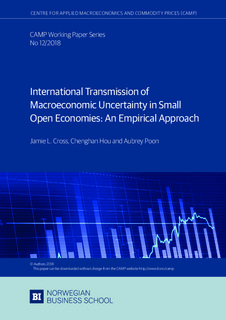International Transmission of Macroeconomic Uncertainty in Small Open Economies: An Empirical Approach
Working paper

Åpne
Permanent lenke
http://hdl.handle.net/11250/2577492Utgivelsesdato
2018-11Metadata
Vis full innførselSamlinger
Sammendrag
We estimate the effects of domestic and international sources of macroeconomic uncertainty in three small open economy (SOE) inflation targeting countries: Australia, Canada and New Zealand. To this end, we propose a structural VAR model with a common stochastic volatility in mean component, and develop an efficient Markov chain Monte Carlo algorithm to estimate the new model. An important feature of the model is that it allows us to test various hypotheses in an internally consistent manner. Our main result is that international uncertainty spillovers shape the macroeconomic conditions in all SOEs. The general mechanism is that international uncertainty shocks reduce real GDP, while raising inflation and interest rates. Domestic uncertainty shocks are found to have a similar effect on inflation and interest rates, however the real GDP responses are idiosyncratic. In particular, the transmission of domestic uncertainty shocks is found to be negative in Canada and positive in New Zealand, while the Australian response is initially negative and becomes positive over time. While the Canadian responses are similar to established results on the US economy, our findings highlight potentially different transmission mechanisms in Australia and New Zealand. Finally, in a forecasting exercise, we show that accounting for macroeconomic uncertainty via our model specification provides more accurate point and density forecasts compared to commonly used benchmarks.